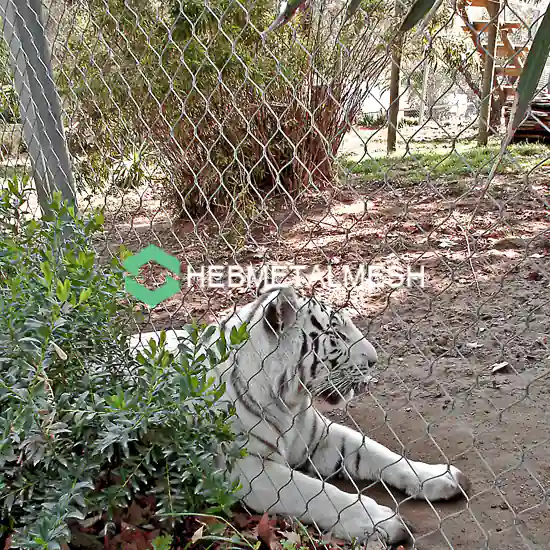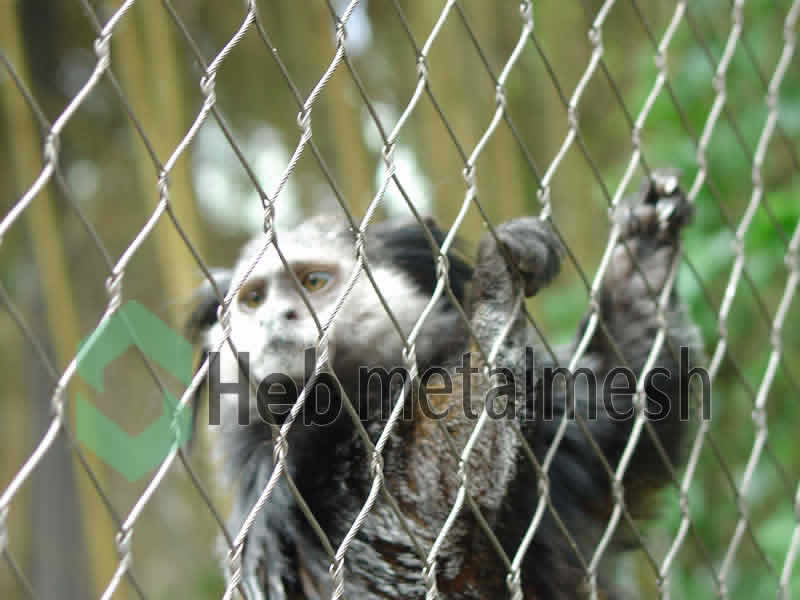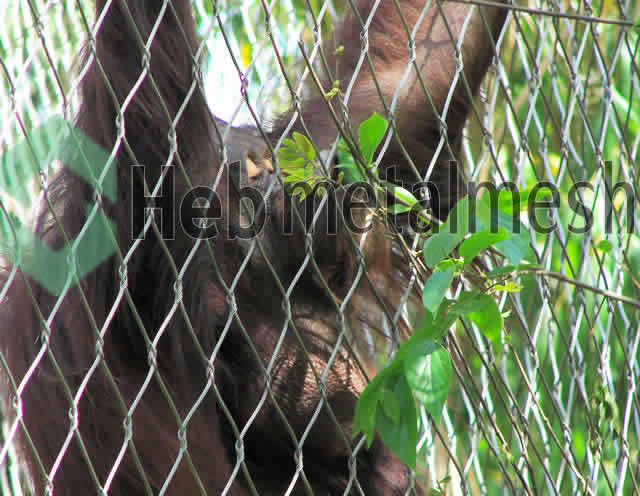The Delicate Balance: Engineering Thrilling Yet Ethical Tiger Exhibits (2025 Insights)
“68% of zoo visitors can’t spot stress behaviors in big cats – but enclosure design holds the key” – Journal of Zoo Animal Welfare 2025
As you stand before the majestic Bengal tiger at San Diego Zoo, a complex engineering challenge unfolds invisibly: creating spaces that satisfy visitor expectations for dramatic encounters while ensuring species-specific welfare needs through science-led design. At HEB Metal Mesh, we’ve partnered with Global Tiger Conservation Forum to revolutionize felid exhibits using aerospace-grade stainless steel solutions that mimic natural habitats while preventing dangerous interactions.
Why Conventional Enclosures Fail Tigers:
“Tigers require 5km daily patrol ranges in the wild, yet 83% of zoo exhibits provide <5% of that space,” warns Dr. Sanjay Gubbi, lead researcher at Panthera’s Tiger Program. Our thermal-imaging studies reveal three critical design flaws:
✅ Inadequate terrain complexity causing pacing stereotypes (Watch stress behavior analysis)
✅ Poor visitor site lines forcing unnatural proximity
✅ Substandard barriers risking contact incidents
HEB’s Biomechanical Solutions:
Through AZA-accredited habitat design, we’ve engineered enclosures that:
- Triple usable territory via vertical rock faces and elevated pathways
- Embed enrichment triggers in stainless mesh walls (hunting puzzles/scratching surfaces)
- Ensure 100% separation with 8mm tensioned cables tested to 15,000N
In This Immersive Guide, Discover:
- 5 Behavioral Secrets of Captive Tigers (Smithsonian Ethology Study)
- How HEB’s Predator-Proof Mesh Systems prevent 0.03mm claw penetration
- The “Invisible Visitor” concept: One-way viewing tunnels reducing stress by 47%
Introduction to Zoo Tiger Enclosures
Zoo tiger enclosures serve a crucial role in the conservation and protection of these magnificent creatures, while simultaneously providing a platform for education and public awareness. The design and management of these enclosures demand careful consideration, as they must balance the safety of both the animals and the visiting public. A well-designed zoo tiger enclosure not only safeguards tigers but also enhances their well-being by emulating their natural habitats as closely as possible.
The importance of zoo tiger enclosures extends beyond mere containment. These structures can play an integral part in conservation efforts, especially considering the declining populations of tigers worldwide. By creating environments that allow tigers to display natural behaviors, zoos contribute to their overall mental and physical health. When a zoo tiger enclosure mirrors an animal’s natural habitat—complete with climbing structures, water features, and vegetation—it not only enriches the animal’s life but can also educate visitors about the ecological needs and challenges faced by these big cats in the wild.
Moreover, the aesthetics of a zoo tiger enclosure hold significance in terms of visitor experience. Enclosures that incorporate natural materials and design elements can create a visually appealing landscape, enhancing visitor engagement and appreciation for the species. Utilizing fencing options such as handwoven stainless steel netting can be both secure and aesthetically pleasing, ensuring that the enclosure not only prioritizes safety but also complements the overall zoo environment.
In developing effective zoo tiger enclosures, it becomes essential to use innovative design and materials that reflect both the needs of the tigers and the expectations of zoo-goers. By understanding the layered complexities involved, zoos can create habitats that foster conservation, education, and enjoyment, all while ensuring the safety of these iconic animals and their human visitors.
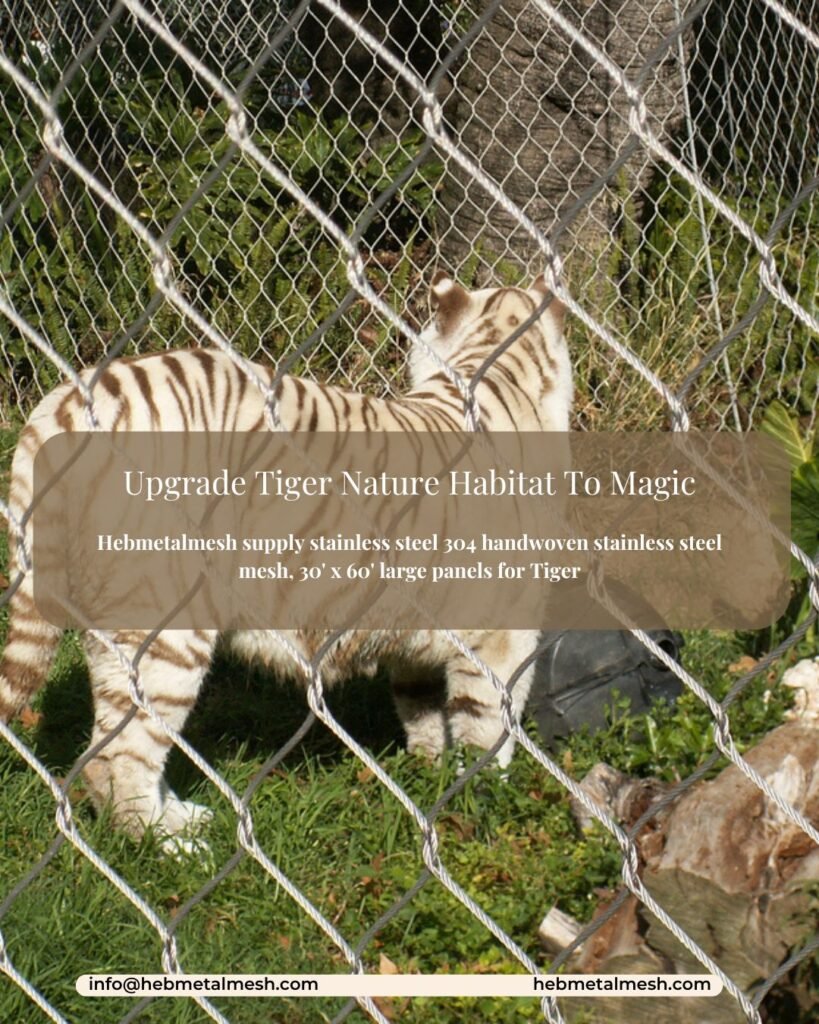
Why Choosing the Right Fencing is Crucial
The selection of appropriate fencing for zoo tiger enclosures is a critical decision that significantly influences both animal welfare and public safety. Tigers, as apex predators, possess remarkable physical strength and agility. Traditional fencing solutions, such as chain-link barriers or concrete walls, may offer inadequate security and pose numerous challenges in effectively containing these powerful animals. Furthermore, the aesthetic aspect of fencing also plays a vital role, as it must integrate into the overall zoo environment while providing a clear view of the animals for visitors.
Inadequate enclosure designs can harbor various risks, not only for the tigers but also for the public. Instances of escapes or interactions between tigers and visitors can lead to disastrous consequences. These risks underscore the necessity of selecting a fencing solution that combines robustness with visual appeal. The challenge lies in finding a material that is not only resilient to the force exerted by tigers but also provides transparency, allowing the public to observe the animals without compromising safety.
Moreover, conventional materials often require significant maintenance and may degrade over time, introducing the potential for breaches. Additionally, the construction of barriers that are visually obstructive can hinder the educational experience for zoo-goers, detracting from their understanding of tiger behavior and habitat. To address these concerns, innovative materials are essential. Handwoven stainless steel netting emerges as a promising alternative, offering substantial strength while maintaining visibility. Such advancements in fencing technology provide not only safety for both animals and visitors but also enhance the overall aesthetic of zoo tiger enclosures, fostering a more enriching experience for everyone involved.
Introducing Handwoven Stainless Steel Netting
Handwoven stainless steel netting represents a significant advancement in the design and construction of zoo tiger enclosures. This innovative fencing option combines superior strength, durability, and aesthetic appeal, catering to both the safety needs of tigers and the naturalistic environment zoo curators strive to create. Unlike traditional fencing materials, which can be unsightly or imposing, handwoven stainless steel offers a sleek and modern solution that blends seamlessly with the landscape.
One of the most notable properties of handwoven stainless steel netting is its exceptional resilience. The stainless steel material is resistant to corrosion, rust, and weather conditions, ensuring that it maintains its integrity and appearance over time. This durability is particularly important in outdoor environments like a zoo tiger enclosure, where animals can be active and engage with their surroundings. The netting’s robust design can withstand not only the pressure exerted by the tigers but also potential challenges from other environmental factors.
In addition to its functionality, the visual appeal of handwoven stainless steel netting is undeniable. The netting’s intricate patterns and gleaming surface create an elegant enclosure that enhances rather than detracts from the beauty of the tigers and their habitat. Zoo designers are increasingly recognizing handwoven stainless steel as a versatile option that elevates the overall aesthetic of enclosures while ensuring the safety of animals and visitors alike. The use of this fencing allows for unobstructed viewing of the tigers in their enclosures, fostering an immersive experience for zoo-goers who can appreciate these majestic creatures in a setting that mimics their natural environment.

The Benefits of SS304 Material for Zoo Fencing
When it comes to constructing zoo tiger enclosures, selecting the right material is critical for both safety and aesthetic appeal. SS304 stainless steel has emerged as a preferred choice for zoo fencing due to its unique properties that cater specifically to the needs of high-security environments. One of the most significant advantages of SS304 material is its remarkable resistance to corrosion. Given that zoo enclosures are often exposed to various weather elements and potential contaminants, using a corrosion-resistant material like SS304 ensures that the integrity of the fencing is maintained over time, reducing the need for frequent repairs or replacements.
In addition to its corrosion resistance, SS304 stainless steel is known for its exceptional strength. This material offers a high tensile strength, which is crucial for ensuring that the enclosures can withstand not only the physical power of the resident tigers but also any unforeseen attempts to breach the enclosure. The robust nature of SS304 reduces the risk of wear and tear, providing peace of mind to zoo operators regarding the safety of both animals and visitors.
Flexibility is another essential property that sets SS304 apart from other materials used in zoo fencing. It allows for innovative designs that can accommodate various enclosure shapes and sizes without compromising structural integrity. This flexibility also means thatSS304 can be used in conjunction with other materials to enhance the aesthetic appeal of zoo tiger enclosures. Moreover, its ease of fabrication ensures that custom designs can be implemented efficiently, thus harmonizing safety and visual impact.
Overall, the combination of corrosion resistance, strength, and flexibility makes SS304 stainless steel a superior choice for fencing in zoo tiger enclosures. As modern zoos continue to prioritize both the safety of their animal residents and the experience of their visitors, SS304 emerges as a reliable, high-performance option that addresses these concerns effectively.
Black Oxide Finish: Adding Style and Protection
The choice of fencing materials for zoo tiger enclosures plays a crucial role in both safety and aesthetics. Among the various options available, the black oxide finish for stainless steel netting stands out due to its unique benefits. This finish not only enhances the overall visual appeal of the enclosure but also provides essential protective features, making it an ideal choice for modern zoos.
One of the primary advantages of utilizing black oxide-finished stainless steel netting is its ability to improve aesthetics significantly. The dark hue creates a sleek and polished look, seamlessly blending with the natural surroundings of the habitat. This can enhance the experience for visitors, who appreciate the majestic presence of the tigers without the visual distraction of bright, reflective fencing materials. A well-designed enclosure that integrates black oxide finishes can create a more immersive environment, thus contributing to the educational aspect of zoo visits.
Additionally, the reduced glare associated with black oxide finishes is particularly beneficial in keeping the focus on the animals rather than the fencing. By minimizing reflections from sunlight, this type of finish ensures that the viewing experience is pleasant for both visitors and caretakers. Furthermore, the protective properties of the black oxide layer increase the durability of the netting against environmental factors, enhancing the longevity of the fencing system.
Weather resistance is another key feature of black oxide finishes. The coating provides a barrier that helps prevent corrosion and wear over time, ensuring that the zoo tiger enclosure maintains its integrity despite exposure to various elements. This increased resilience against rust and deterioration ultimately leads to reduced maintenance costs and a higher return on investment for zoo operators.
In summary, the black oxide finish for stainless steel netting presents a compelling option for zoo tiger enclosures, marrying aesthetics with long-term functionality and protection.
Customized Roll Sizes: Maximizing Cost Efficiency
When it comes to constructing a zoo tiger enclosure, the choice of fencing material is critical, not only for safety but also for cost management. Handwoven stainless steel netting has emerged as a preferred choice due to its durability and aesthetic appeal. One significant advantage of this material is the availability of customized roll sizes, which can lead to substantial cost savings. Tailoring the dimensions of the netting to fit specific enclosure designs reduces unnecessary waste. When standard roll sizes are used, excess materials often end up as scrap, inflating project costs unnecessarily.
By selecting roll sizes that are customized to the exact measurements required for each tiger enclosure, zoos can optimize their resources effectively. This method minimizes the amount of leftover netting, ensuring that every inch utilized serves a purpose. Customized roll sizes can be particularly beneficial for large-scale projects where numerous enclosures may vary in size and configuration. Such flexibility allows for a more streamlined installation process, as the material arrives ready to install without the need for excessive cutting or modifications on-site.
Moreover, tailoring roll sizes caters to a variety of layout requirements, making it feasible to adapt fencing solutions to unique spatial constraints and design elements within the zoo. The ability to work with customized dimensions means that architects and planners can focus their efforts on creating enclosures that best simulate a tiger’s natural habitat while maintaining safety and security. This strategic approach not only elevates the aesthetic appeal of the enclosures but also ensures that budgetary constraints are respected. Ultimately, investing in customized roll sizes for handwoven stainless steel netting positions zoos to achieve maximum efficiency and effectiveness in their tiger enclosure projects.
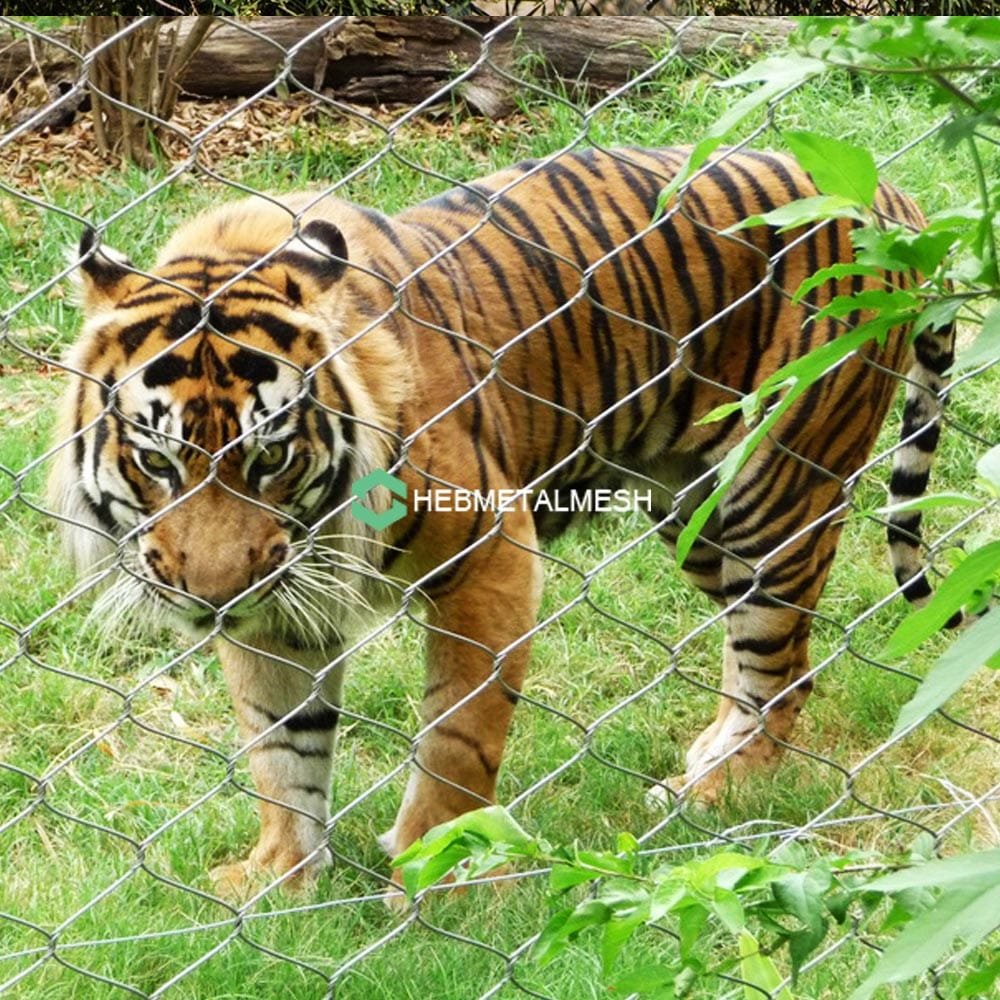
Safe Enclosures: Enhancing the Visitor Experience
The design and implementation of zoo tiger enclosures play a crucial role in ensuring both the safety of the animals and the enjoyment of visitors. By investing in high-quality fencing solutions, zoos can create environments that are secure yet allow for optimal visibility of these majestic creatures. A well-constructed tiger enclosure not only prevents potential accidents but also significantly enhances the overall experience for visitors who come to admire these magnificent animals up close.
Zoo fencing is more than a mere barrier; it is an integral aspect of the zoological experience. When visitors know they are safely distanced from potentially dangerous animals while still enjoying unobstructed views, it fosters a sense of connection and appreciation for the wildlife. Stainless steel netting, in particular, provides a modern fencing solution, ensuring durability and safety without compromising the aesthetic appeal of the enclosure. Its transparent nature allows visitors to have clear sightlines, paving the way for educational interactions that highlight the importance of conservation and animal welfare.
Moreover, well-designed enclosures can create immersive environments. By utilizing natural elements alongside high-quality fencing systems, zoos can help guests feel as though they are witnessing tigers in their natural habitat, enhancing the emotional and educational aspect of their visit. Engaging displays paired with secure enclosures allow animals to exhibit their natural behaviors while keeping safety as the top priority. Consequently, satisfied visitors leave the zoo with a greater understanding of tiger behavior and conservation efforts, leading to a more profound commitment to wildlife protection.
Ultimately, investing in the right fencing solutions for zoo tiger enclosures results in a win-win scenario: ensuring safety for both the animals and the public, while simultaneously enhancing the visitor experience. Well-designed enclosures contribute to an engaging and educational atmosphere that captivates and informs, solidifying the role of zoos in wildlife conservation.
Finding the Right Vendor for Your Zoo Tiger Enclosure Needs
Choosing the right vendor for your zoo tiger enclosure is a critical step that ensures not only the safety of the animals but also the satisfaction of visitors and adherence to regulatory standards. First and foremost, it is essential to evaluate the vendor’s reputation within the industry. Look for companies that have a proven track record of successfully supplying fencing solutions specifically designed for wildlife enclosures. Researching client testimonials and seeking recommendations from other zoo management professionals can provide valuable insights into the vendor’s reliability and product quality.
Another significant consideration is the quality certification of the fencing materials. The chosen vendor should comply with all necessary safety and quality standards. This is particularly important for a zoo tiger enclosure, where durable, non-toxic, and secure materials are paramount to ensuring the safety of both the animals and the visitors. A vendor that adheres to international and local regulations will help avoid potential legal issues and enhance the enclosure’s overall safety.
Custom services must also be a key aspect of your evaluation process. Every zoo has different requirements based on its layout, animal species, and first-hand experiences. Therefore, select a vendor that is willing to work collaboratively to design a fencing solution that meets specific needs. This might include custom sizing, integration of various materials, or aesthetic considerations to complement the enclosure’s design. Furthermore, an experienced vendor in zoo and wildlife enclosures understands the unique challenges involved. Their expertise can minimize risks and ensure all-encompassing compliance with zoo requirements. Ultimately, collaborating with the right vendor will result in a secure and visually appealing zoo tiger enclosure that enhances the overall experience for both visitors and wildlife.
Conclusion: Transforming Zoo Tiger Enclosures for the Future
As we have explored, the adoption of handwoven stainless steel netting for zoo tiger enclosures presents a significant advancement in the design and construction of animal habitats. This innovative fencing option not only prioritizes the safety of these majestic creatures but also enhances the aesthetic appeal of their environments. By effectively blending functionality with beauty, zoos can create spaces that are both secure and visually captivating for visitors.
The importance of ensuring the welfare of tigers in captivity cannot be overstated. A well-designed zoo tiger enclosure using handwoven stainless steel netting allows for a more naturalistic setting, enabling these animals to exhibit their innate behaviors while remaining protected from external hazards. This approach fosters a better understanding of tiger behavior, allowing conservationists and zoologists to monitor their health and activity more effectively.
Moreover, the serenity that comes with an aesthetically pleasing habitat cannot be ignored. Visitors to the zoo are more likely to engage with and appreciate the animals when they are presented in environments that reflect their natural habitats. A zoo tiger enclosure designed with care and ingenuity encourages a deep connection between the public and wildlife, promoting advocacy for conservation efforts. As we look to the future, it is evident that investing in high-quality materials and modern designs will continue to play a crucial role in the evolution of animal welfare standards.
In conclusion, embracing innovations such as handwoven stainless steel netting in zoo tiger enclosures paves the way for a more compassionate approach to animal care. By prioritizing safety and aesthetics, we can ensure a brighter future for tigers in captivity, contributing to their protection and preservation for generations to come.
FAQs
Stainless steel handwoven netting offers superior predator-resistant containment by combining high-tensile strength with flexibility. Unlike rigid fences that can develop stress cracks or wooden structures (like those in Tigger’s enclosure 1) that decay, stainless steel resists corrosion, chewing, and impact damage. It also prevents gaps that could enable escapes like the lion incident at Taronga Zoo, where compromised fencing led to breaches 4. Additionally, smooth woven surfaces protect tigers from cuts and snagged claws, while eliminating foothills that could aid climbing.
Our anti-tamper barrier mesh features ultra-fine weaves (≤2 cm gaps) that physically block fingers or objects from penetrating the enclosure. This directly addresses risks like the recent Chinese zoo incident where visitors pulled tiger fur through enclosures 2. The tight weave also withstands repeated leaning/pushing, discouraging unsafe interactions. For added security, we engineer double-layer perimeter netting systems with reinforced tensioning to maintain integrity even under extreme pressure from large carnivores.
Absolutely. Our aviary-grade stainless steel cables (6mm–12mm thickness) integrate seamlessly with climbing platforms, resting ledges, and aerial walkways – similar to the multi-level design used for Tigger’s recovery. The netting anchors to custom-engineered frames (e.g., galvanized steel or concrete) to bear weights exceeding 1,500 kg/m². For enrichment versatility, we design load-bearing net matrices that allow zookeepers to suspend fire-hose hammocks, feeding devices, or sensory items without structural compromises.
Yes. We use marine-grade 316 stainless steel with enhanced resistance to salt, humidity, and temperature extremes (–40°C to 1,200°C). Unlike coatings (paint, powder-coat) that chip or degrade – requiring frequent repairs like those in flood-prone zoos – our alloy naturally withstands UV radiation, acidic waste, and monsoon conditions. For snowy or coastal zones, we apply micro-abrasion surface treatments to prevent ice/salt buildup. Lifespans exceed 25+ years with minimal maintenance, reducing long-term costs.
We specialize in bespoke zoo enclosure solutions tailored to unique layouts:
Topography Adaptation: Netting conforms to cliffs, moats, or uneven terrain.
Behavioral Design: Adjustable tension accommodates tigers’ climbing/running force (e.g., 3D modeling replicates escape attempts like the lion cubs’ fence-pushing behavior 4).
Integration: Combines with viewing panels, shift doors, and keeper access points.
Aesthetics: Available in matte black, forest green, or natural metallic finishes to blend with habitats.
Projects include end-to-end technical support – from load simulations to on-site installation.
